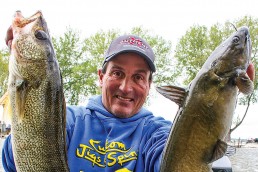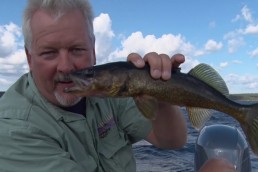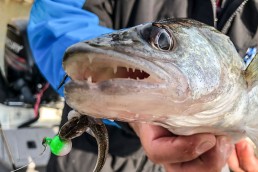September Fishing Info for Walleyes and More!
SHARE THIS POST
Looking for some productive techniques to try this fall then read on, because I’ve got some hot ones. These are some of tried and true methods of fish catching that other anglers pass up and it’s the little details that will produce some trophy fish!
Clear-water walleye
Want a huge walleye? Work the rocky points, reefs and weed edges. When it’s a sunny day the fish will be in the weed edge or off of the reef on the shady side. On a cloudy day, they will pull up on the shallow water of the point or reef and be out a little ways from the weed edge.
A jig and minnow, leech or plastic will get their attention. I like a B-Fish-N H2O jig with a Pulse-R tail beefed up with bait this time of year. You’ll want a jig just heavy enough to control, but not too heavy to snag. You might have to try different weights and you should have a few rods rigged with different weights as you work your way around different depths (H2O jigs have the weight stamped on them for easy selection).
A second rod can be rigged with a 1/4-ounce B-Fish-N Draggin’ Jig and some bait. The head design of the Draggin’ Jig keeps it from snagging up which would normally happen on the rocks.
It’s all great fun when you can see walleye pinned to the bottom and vulnerable to these presentations, but sometimes they will be suspended a foot or two off bottom. What to do, then? Simply lift your jigging rod up a foot or so and hold it there. As depths change, you will need to drop back to find bottom and then lift the rod back up into the strike zone. The Pulse-R tail will be in constant attracting motion as you hold your rod.
When fishing the weed edge you can apply all of the above discussed techniques, except when it’s sunny and the fish bury themselves in the weeds. Here, it’s best to pitch a baited Draggin’ Jig into the weeds and jiggle it back through. Snagging the jig up and jiggling it free is a great fish attractor! You can also drag a second Draggin’ Jig behind the boat for an added bonus.
Are you enjoying this post?
You can be among the first to get the latest info on where to go, what to use and how to use it!
Trolling shallow in stained water
The other day I was trolling in three to six feet of water, looking for walleyes or white bass on Castle Rock Lake, in Wisconsin. I was using small Salmo Hornet crankbaits when a walleye hit and then seemed to get snagged up. The snag turned out to be a muskie of at least 45 inches, and after an adventurous battle on a 10-foot noodle rod, the fish got off when it saw the net.
The next day in the same area, I caught a 30-inch muskie on that little crankbait, and then the next time out, two weeks later, a 38-inch pike, as well as walleyes and white bass. So the point is, when the bait is shallow, the big fish follow.
Anglers who troll like to focus on deep-water structure and areas that are easy to spread out lines and boards without snagging up. On stained water lakes formed by river systems like the Fox Chain of Lakes, the Winnebago system and the Castle Rock Flowage, sometimes shallow water is where the fish hold.
Trolling shallow requires a lot of energy. You can hand hold the rod and pull it forward and release it back which gives a lot of movement to the crank. Steering left, then right, back and forth might look crazy, but this, too, gives the cranks a lot of action. Vary your trolling speed, also. Troll between 1.8 and 3.5 mph and constantly keep moving your boat left to right.
You can run all sorts of cranks shallow in stained water, even deep divers. I’ve trolled up huge walleyes right under the boat in four feet with 10 feet of line out. Sounds crazy, but it works. Usually I’ll run shallow runners 40 to 60 feet back and deep runners 10 to 20 feet back.
Baits of choice: Berkley Flicker Shads, Salmo Hornets and whatever else looks fishy in the giant tackle box. Let out just enough line out that the lure ticks bottom, and as you run deeper, let out more line…in other words, keep reeling in and letting out until the right zone is found.
MWO
SHARE THIS POST
Did you enjoy this post?
You can be among the first to get the latest info on where to go, what to use and how to use it!
Walt Matan
Walt Matan has been a writer and television host for MidWest Outdoors for 30 years. An avid ice and open-water fisherman, he currently lives in the Quad Cities on the shores of the Mississippi River. He is the product developer and brand manager for Custom Jigs & Spins, B-Fish-N Tackle, and Rippin Lips Catfish Tackle. For more information visit customjigs.com.



